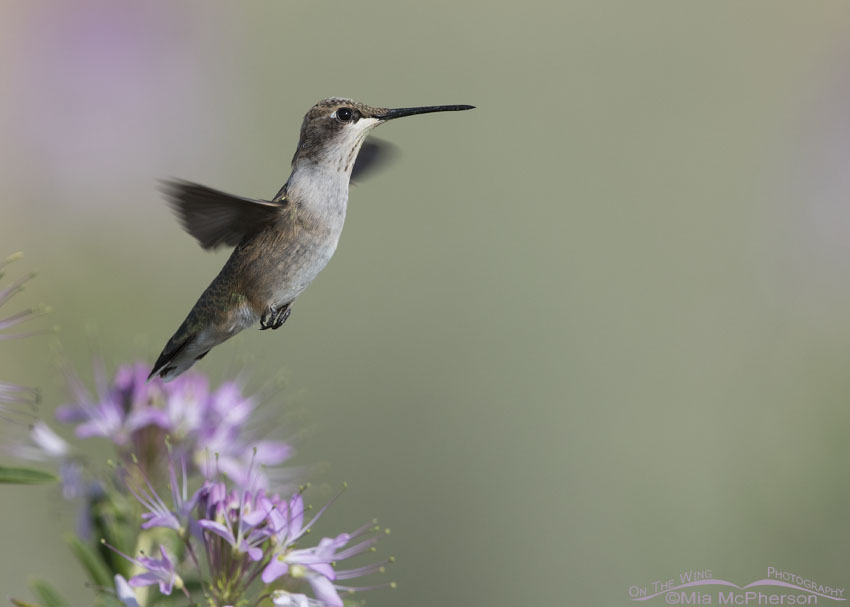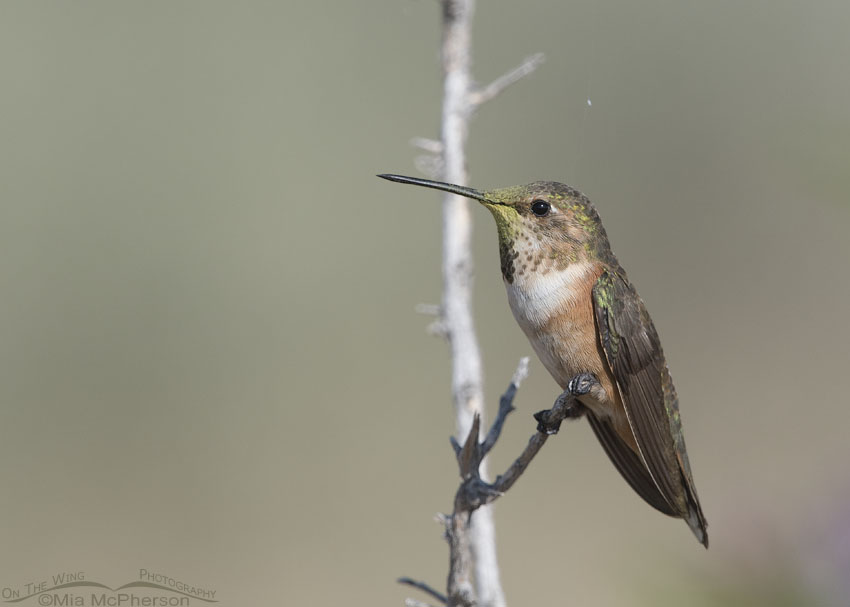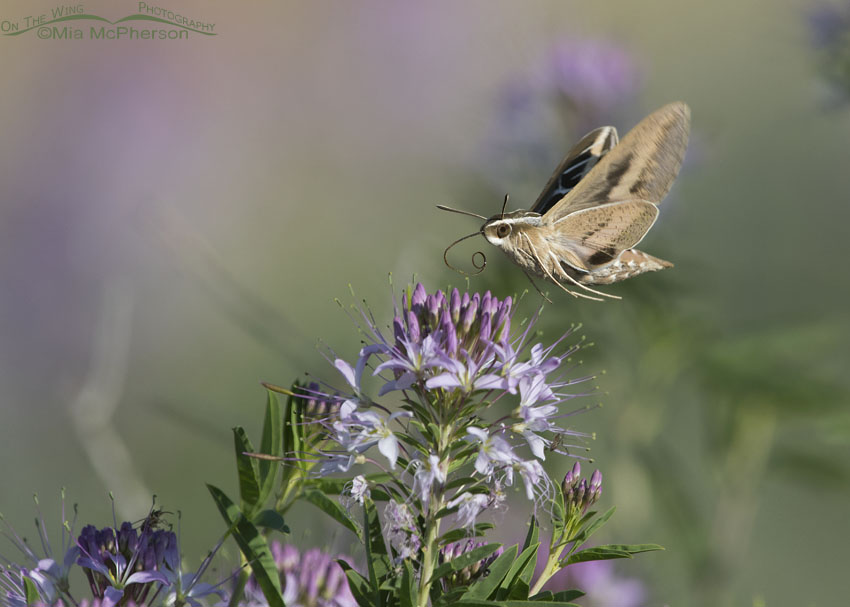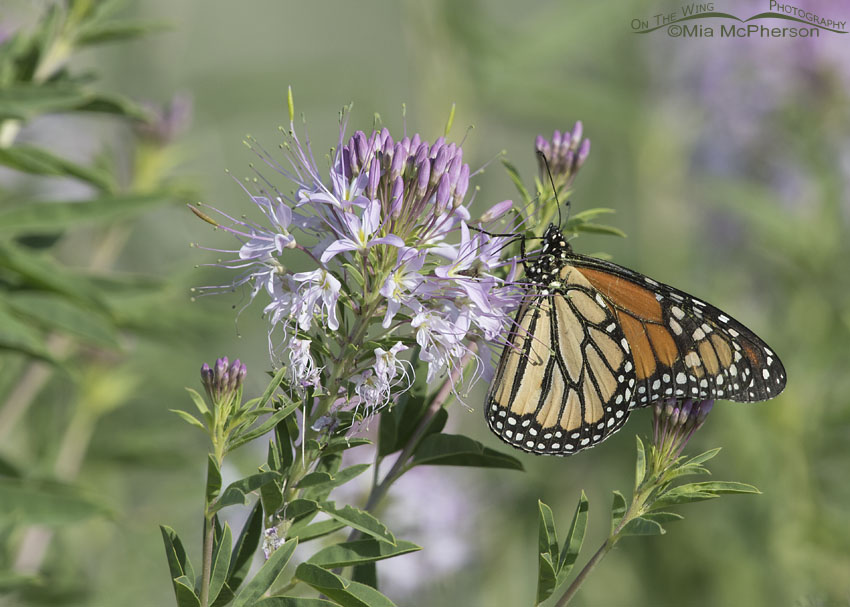 Black-chinned Hummingbird on Antelope Island – Nikon D500, f7.1, 1/2000, ISO 400, -0.3 EV, Nikkor 500mm VR with 1.4x TC, natural light, not baited or set up
Black-chinned Hummingbird on Antelope Island – Nikon D500, f7.1, 1/2000, ISO 400, -0.3 EV, Nikkor 500mm VR with 1.4x TC, natural light, not baited or set up
Rocky Mountain Bee Plants are blooming all over the Salt Lake Valley right now and those beautiful, spider-like flowers are attracting hummingbirds, moths, butterflies, bees and a host of insects. When I had a garden I used to grow cleomes because they attracted so many different birds and insects but now I enjoy the wild cleomes like Rocky Mountain Bee Plants (Cleomella serrulata) instead. They don’t bloom for very long but they are glorious when they are in full bloom.
The blooms attract Black-chinned Hummingbirds who hover over the flowers, sip their nectar and chase off the other hummingbirds that fly in.
 Young Rufous Hummingbird on Antelope Island – Nikon D500, f7.1, 1/2000, ISO 400, -0.3 EV, Nikkor 500mm VR with 1.4x TC, natural light, not baited or set up
Young Rufous Hummingbird on Antelope Island – Nikon D500, f7.1, 1/2000, ISO 400, -0.3 EV, Nikkor 500mm VR with 1.4x TC, natural light, not baited or set up
The flowers also attract Rufous Hummingbirds who have already begun their fall migration. They are colorful, flashy and amusing little hummingbirds because they can be so aggressive. I hope to one day photograph an adult male at Rocky Mountain Bee Plants in all his glory.
 White-lined Sphinx Moth hovering over flowers – Nikon D500, f7.1, 1/1600, ISO 400, -0.3 EV, Nikkor 500mm VR with 1.4x TC, natural light
White-lined Sphinx Moth hovering over flowers – Nikon D500, f7.1, 1/1600, ISO 400, -0.3 EV, Nikkor 500mm VR with 1.4x TC, natural light
The moths I see the most at Rocky Mountain Bee Plants are White-lined Sphinx Moths who move quickly just like the hummingbirds do, in fact some people call them Hummingbird Moths. This photo doesn’t show the lovely pink colors these moths have but I wanted to share it because the tongue, or the proboscis is clearly visible in this photo. When they aren’t using it to sip nectar it is curled up like a party noisemaker and as much as I dislike the noise those things made I do love how they curled up.
 Monarch Butterfly nectaring on Rocky Mountain Bee Plant – Nikon D500, f7.1, 1/1600, ISO 400, -0.3 EV, Nikkor 500mm VR with 1.4x TC, natural light
Monarch Butterfly nectaring on Rocky Mountain Bee Plant – Nikon D500, f7.1, 1/1600, ISO 400, -0.3 EV, Nikkor 500mm VR with 1.4x TC, natural light
Monarch Butterflies are also on the move and they stop at the Rocky Mountain Bee Plants to fuel up on the nectar too. Monarch Butterflies are in trouble so I celebrate any plant or flower that helps them along.
I hope to find more Rocky Mountain Bee Plants that are accessible with hummingbirds, moths, bees and butterflies nectaring on them over the nest few weeks. They all delight me.
Life is good.
Mia
Click here to see more of my hummingbird photos. Click here to see more of my insect and spider photos.


What a goldmine of pics! Incredible detail. Thx Mia.
So beautiful!
My senses are overflowing with that experience.
Thank you for taking us along with you!
Sue
Ooooh. And ahhh.
And thanks for the reminder about planting cleome again this season.
Oh Mia…how spectacular! As I slowly do my landscape here, everything will nurture wildlife, although I do NOT want to attract the snakes and scorpions in the neighborhood! I’d like to DIScourage them in every way possible while giving the birds and other insects a safe haven. Hope I can accomplish that.
Wonderful pictures Mia!
Beautiful images, Mia! So nice to see many different pollinators attracted to one type of (lovely) flower.
I agree with Kim…these are all wonderful ,wonderful shots!!! The detail is incredible…BEAUTIFUL!!!
I agree with Kim…these are all wonderful ,wonderful shots!!! The detail is incredible…BEAUTIFUL!!!
These sphinx moths are just outstanding… if never seen one prior to viewing yours and Ron’s photos… and the hummers…. SWOON!! I love the monarchs too… I have seen several this year, but no gulf fritillaries, which I had come to expect… last year we had a ton of fritillaries… I planted flowering natives along with a few of the usually – butterfly bushes, penstemons, monkeyflowers, epilobiums….
Joy to see! Thanks…
Fantastic images. The moth image is perfect!
Lovely, lovely, lovely images for the morning coffee. Thank you!